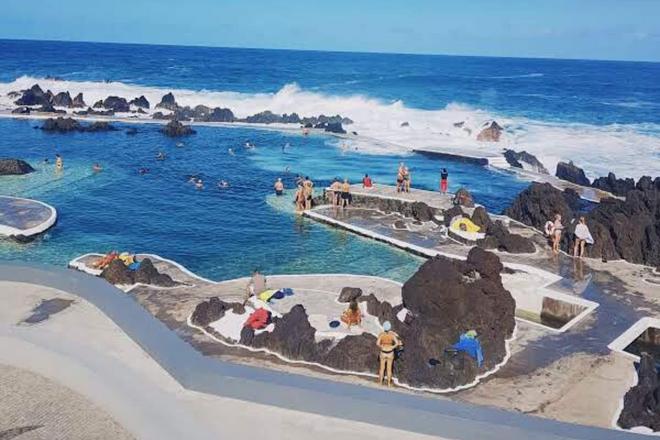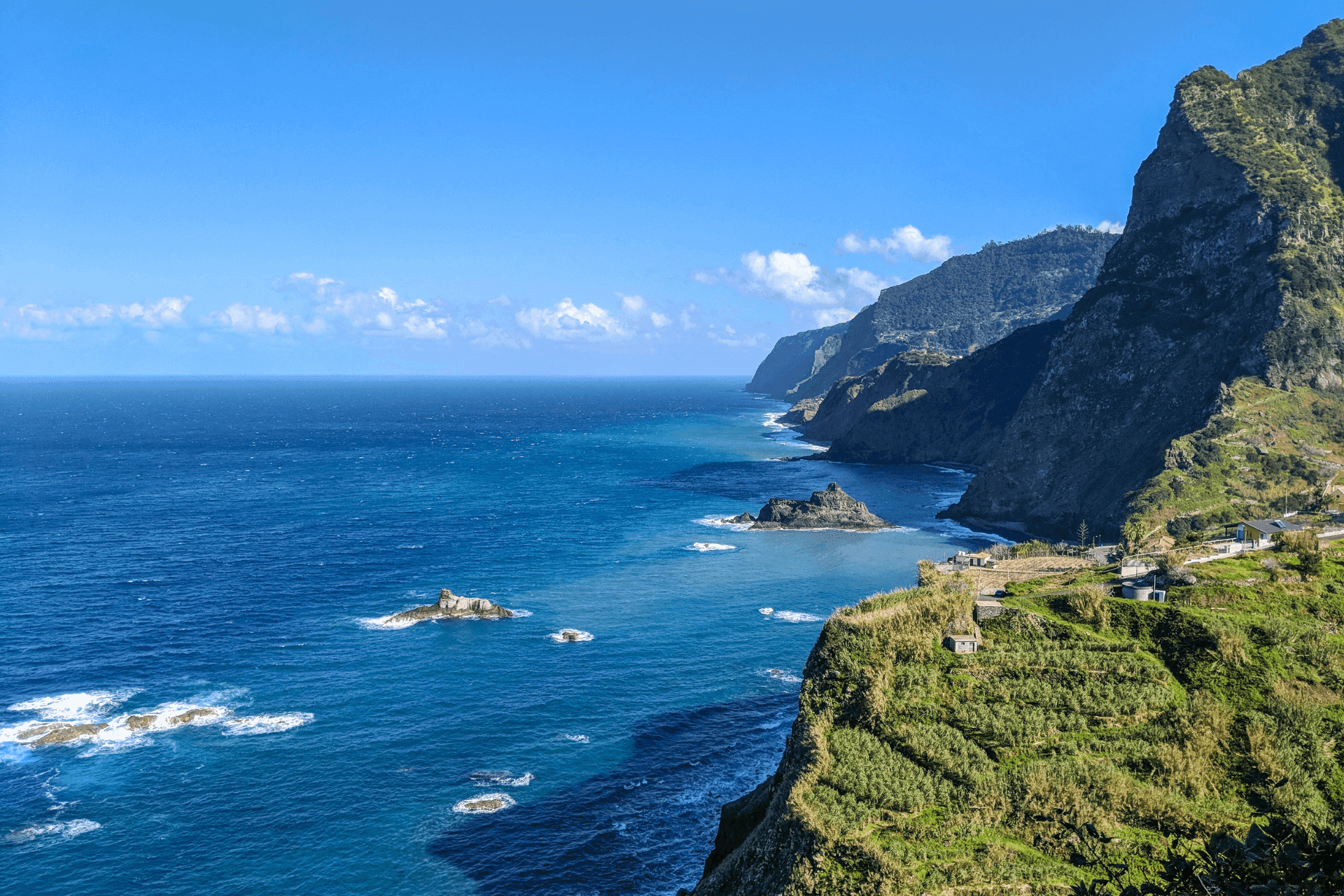Madeira is known as the island of eternal spring, or the miniature continent. It is a paradise of colourful flowers with a year-round pleasant climate and a huge variety of landscapes of native tertiary forests, with bizarre volcanic peaks accessed by a network of hiking trails and unique levadas.
Diverse nature and weather
The Portuguese archipelago of Madeira, about 1,000 kilometres southwest of Lisbon, is volcanic in origin, and nature has managed to create an amazing array of scenery over millions of years. The diversity of the landscape here is incredible. You can find every conceivable type of landscape on the island's expanse. The easternmost cape of the island is practically a semi-desert and the colourful and rugged nature of its volcanic landscape makes it greatly exotic for any tourist.
The island's coastline is steep and rocky, and east of the capital you will find one of the highest cliffs in the world, offering breathtaking views not only at sunset. The steep slopes rise from sea level to the central massif of the highest mountains, dominated by the almost 1900 m high peak of the island's highest mountain, Pico Ruivo. The northern slopes, especially at higher altitudes, are covered by a unique misty tertiary laurel forest. The western part of the island is dominated by the Paul da Serra plateau, an uninhabited area of pastureland reminiscent of the Scottish Highlands. The island's population is mainly concentrated on the sunnier southern coast, where we find the capital, Funchal, whose agglomeration resembles a giant amphitheatre over the sea, watching over the local harbour, and which for centuries has been the intersection of the European and American continents. In addition to several deserted islands, the Madeiran archipelago also includes the neighbouring small inhabited island of Porto Santo, which is much visited by tourists heading for its famous sandy beach.
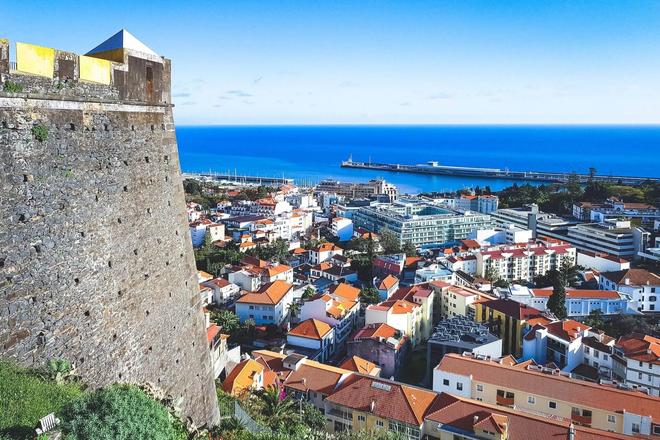
The Madeira archipelago is a place you can visit all year round. In summer, it's not unbearably hot (except for a few days a year when the wind blows in from the Sahara). In winter, the temperatures are very comfortable and you can wear short sleeves in the coastal areas almost all year round. However, weather vagaries are quite frequent, especially in the colder seasons. It's not for nothing that the Madeirans themselves say you can experience four seasons in one day. Typically, it rains in one place on the island and the sun shines just a few kilometres away. The clouds and light also create unique photographic compositions. In short, Madeira is a great choice for an active place to relax and recharge your batteries.
Hiking not only along the levadas
The jagged mountains here with their steep slopes seem like the homes of fairy elves, while the plateau in the western part of the island is reminiscent of Scotland with its moors, grazing herds of cows and rolling mists. Just a few kilometres away, terraced fields grow bananas and sugarcane. Due to the need for irrigation on the warmer but drier southern side of the island, a unique network of water channels has been created over the centuries, running down the steep slopes of the local mountains, known as levadas. The current length exceeds 2000 km. In places where the slopes were so steep that the canal could not be plugged or had to be crossed, water tunnels were built and can usually be passed through.
It is the levadas that have become the basis of the dense network of hiking trails through the mountains, and have made places accessible where it would otherwise be impossible to go, into steep slopes and ravines. It took several centuries and many human lives to build them. The main walking routes are well signposted and secure. One can choose according to difficulty, from very easy to fairly exposed paths, or those not maintained. Many of the hikes involve tunnels, so it is advisable to carry a headlamp. Some of the hikes are several kilometres long, but not on marked trails. The ultimate experience is an aerial ridge hike connecting the highest peaks in exposed mountain terrain with many staircases and tunnels, but so well secured and maintained that the average hiker can manage it. If you go at sunrise, there won't even be many people here yet. Thanks to the inverse cloud cover, you can experience unique scenery reminiscent of Lord of the Rings.
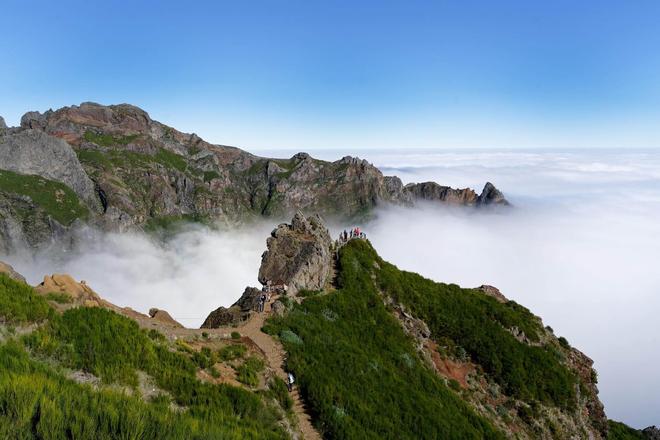
Surfing and canyoning
While hikers will love the mountain hikes along the lava, adrenaline junkies will enjoy surfing or mountain biking. Thanks to the growing popularity of surfing, a number of schools and equipment rental companies have been set up in Madeira. The waves are here all year round. It is also worth mentioning the excellent conditions for canyoning. This is a sport where you crawl through canyons, rappel down waterfalls or jump into lagoons with crystal clear water, without needing any special skills or above-average physical fitness.
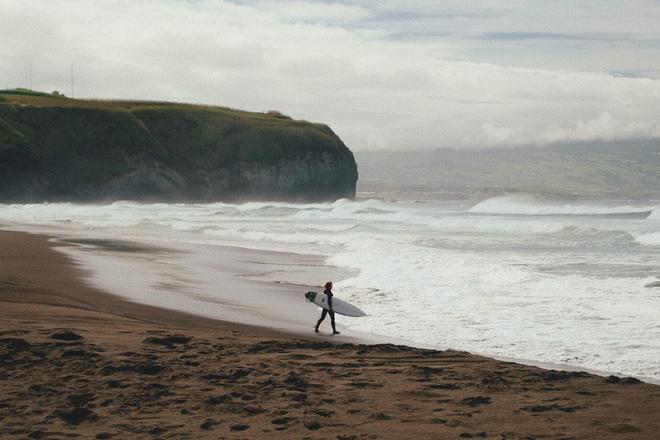
The flowerpot in the middle of the Atlantic
Flower lovers and those who prefer a more relaxed holiday will also find something to enjoy. It's not surprising that Madeira is known as the "island of eternal spring". In Funchal alone, the capital of the archipelago, you can visit several different botanical gardens and spend a whole day there. In fact, one large botanical garden covers the whole island as far as the eye can see. No matter what time of year you visit, Madeira is in bloom. Of course, most tourists are attracted in spring, when the Flower Festival is held. As well as a wealth of flowering plants, there are also native tertiary laurel forests (laurisilva) with many endemics, such as the unusual tree ferns and blueberries. The local subtropical climate with plenty of moisture and year-round balanced temperatures creates ideal conditions for plants and hiking. This makes it possible to enjoy a pleasant New Year's Eve in a short T-shirt and even go for a swim, as well as summer holidays in the subtropics without the heat, because you can always take shelter in the cool, moist rainforest. Madeira really is one of the few destinations you can go to at any time.
The Madeira tribe and the temperament of today's islanders
The history of the island, and its inhabitants of Portuguese origin, are also very varied. Apart from the last few decades, when everything on the island has revolved around tourism, the Madeirans were farmers and traders for centuries. After all, this first piece of land on the Atlantic route from Europe was a logical stop for every ship to replenish provisions and, above all, drinking water. The island's sugar cane crop thrived, its mineral volcanic soil ripened excellent grapes for wine production, and so did its trade. Investors from Portugal, Flanders, Italy and, above all, England settled here. The young Christopher Columbus also traded sugar in Madeira, married and returned here on his voyages of discovery. The common people tried to exploit every inch of the fertile soil. Remnants of terraced fields can still be seen in the least imaginable terrain. The cosmopolitan character of the island and its metropolis was later enhanced by the seasonal presence of the European aristocracy. This included figures such as the Empress Sissi and the last Austrian Emperor and King of Bohemia, Charles I of Habsburg, who died of pneumonia here in poverty in 1922. His grave can be found in the pilgrimage church in the Monte district, part of the capital Funchal.
The islanders have a southern temperament and hospitality, are proud of their origins, honour old customs and traditions and are devout. Traditions manifest themselves throughout the year in the form of various celebrations and festivals. The most interesting are the Flower Festivals. The island is literally a botanical paradise and alongside the native flora you will find exotic plants from literally all over the world. And it is these that make up the decorations of the town and the allegorical chariots and dancers that make their way to the centre of the capital every spring, watched by many tourists and locals alike. Another remarkable highlight of the tourist season is New Year's Eve, when local fireworks displays are considered some of the most spectacular in the world. But let's not forget the many so-called 'festas' – festivals held throughout the year – whether religiously themed or to celebrate the harvest. In short, the islanders love to celebrate and their costumes and folk traditions, such as their distinctive music and dance, have survived for centuries.
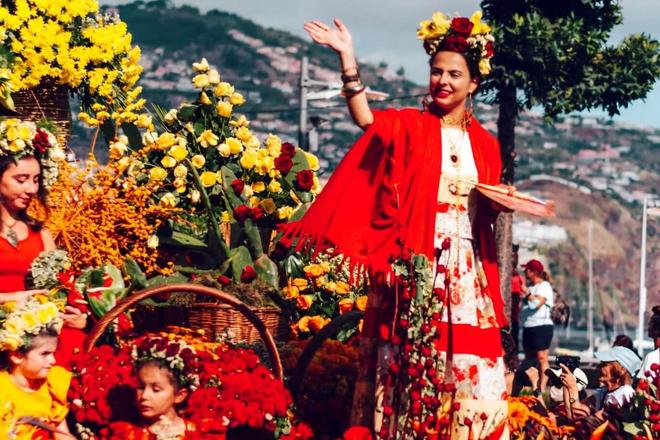
Their buildings also adhere to traditional forms, colours and scales and public spaces, roadsides, churches and chapels are kept clean and decorated with flowers. Exceptions are the large hotel complexes in the western part of Funchal and the houses of returning emigrants who have seen architecture from abroad. One of the most beautiful architectural monuments is the Cathedral of Funchal (Sé), built at the turn of the 15th and 16th centuries in the Manueline Gothic style.
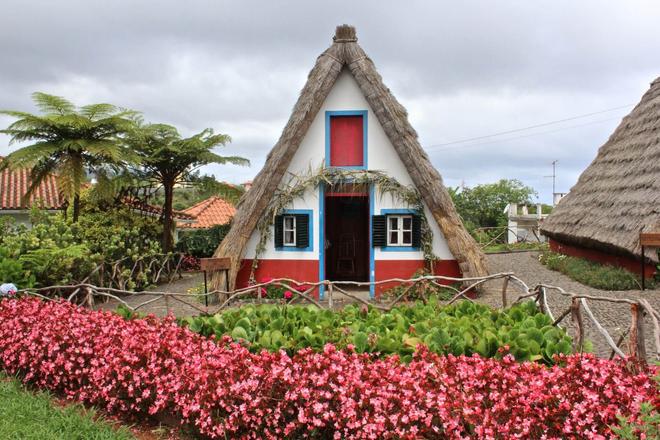
Madeira on a plate
Madeira's cuisine stands out for its great local ingredients. It blends the influences of continental Portuguese cuisine with the ingredients that this subtropical paradise has to offer. Whether it's a variety of exotic fruits and vegetables (which you can sample in the famous Funchal market) or a range of fish specialities, such as grilled cuttlefish (lulas) with delicious garlic bread (bolo do caco). Probably the most famous of these is the at first sight terrifying deep-sea fish called lace fish (peixe espada), prepared in many ways. Classically, it's batter-wrapped, fried and served with roasted banana. Local chefs are likely to recommend tuna or swordfish steaks with delicious steamed vegetables drizzled with olive oil or traditional grilled beef skewers (espetada). As for sweet treats, we have to mention the popular Bolo do mel cake, made with molasses, raisins and nuts. We must not forget the Madeira dessert wine, similar in character to port, and the popular mixed drink poncha made from cane brandy, honey and lemon juice.
Lava pools and golden sand
Although the archipelago of Madeira is not a typical beach destination, either because of its volcanic origins or its steep slopes that drop directly into the ocean, even on the main island you will find several places to swim at the end of a pleasant day. Perhaps the most interesting option is the natural pools on the lava cliffs in the town of Porto Moniz on the northwestern tip of the island. Swimming facilities and protective walls have been built to hold in plenty of water while protecting guests from the crashing waves of the surf that crash against the rocks just in front of them. The less-visited natural lava pools in Seixal will also impress. And if you don't fancy the horseshoe-shaped natural 'Prainha Beach' of pristine black sand outside the town of Caniçal in eastern Madeira, the neighbouring island of Porto Santo, which can be reached in 2.5 hours by boat or 20 minutes by plane, has a nine-kilometre stretch of golden sandy beach and excellent conditions for swimming or water sports.
